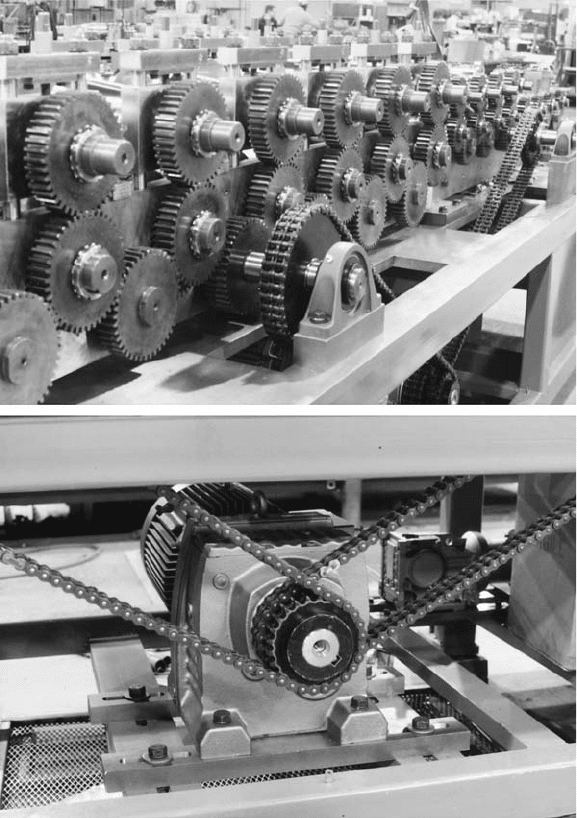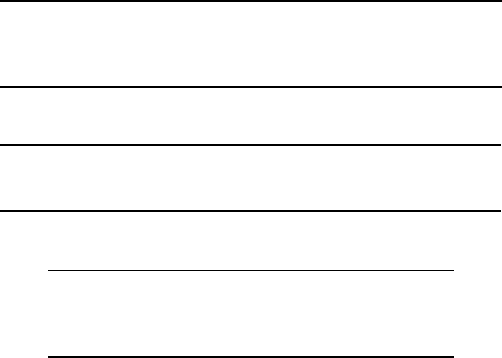Roll Forming Handbook / Edited by George T. Halmos
Подождите немного. Документ загружается.

similar products. Some companies are flourishing and profitable, while others, in spite of these available
opportunities, are struggling,loosing market share, and frequently havetobeclosed down. What makes
the differencebetween winners and losers? It is the people that makethe difference.
People, from the CEO down to the recently hiredapprentices, people who develop and design the
products, purchase the material, makedecisions on the equipment and tooling,schedule the
equipment, lay out the plants, maintain the equipment, but, most importantly,all the equipment
operators and the supervisors, foremen, and plant managers, makethe difference.Ifthe people are
knowledgeable and motivated, the companyhas an excellent chanceofbeing successful. If they are not
trained to do their jobs, then inefficient production, trouble, and squabbles are everydayoccurrences.
Therefore, if acompanywants to be successful, then educating the people at all levels should be abasic
requirement.
Mill operators as well as the plant supervisors should know how to setup and operate the new,
sophisticated lines. Likewise, engineers should know howtodesign better products that can be produced
at lower costs, purchase agents must be aware of new materials, and top executivesmust be familiar with
the latest developments to select and justify better equipment than their competitors.
To setup the rollspersonally and to operate the line for afew weeks is the best, but not necessarily a
practical, approach to becoming proficient in all aspects of roll forming.The roll designer,who had to
setup the rolls, will never forget the problems he/she came across. Apartdesigner will be careful about
wheretolocate the holes or cutouts and where to apply tolerances after trying to roll form parts to
impossibly,and frequently unnecessary, tight tolerances.
Given the chance to setup and operate the lines, management personnel would probably appreciate
moreand consider the “operator friendly” features, easy and accurate adjustability, qualityofthe
equipment and tooling,than the pricealone when making decisions on equipment purchase.
Unfortunately,not ever ybody has the opportunitytosetup and operate the roll forming lines. To
counteract this problem, staffcan be given the opportunity to attend roll-forming courses. They can
update their knowledge and discuss problems with roll forming experts. Continuous education is
essential because of the increasing rate of changes in the industry.
12.8.2 Roll Forming Line Operators
It is difficult to find formal operator training courses. Colleges, schools, and other organizations usually
do not provide coursesfor roll forming line operators. Only afew,more advanced, companies arrange for
organized training courses for their employees. Most mill operators remain attached to the “learn on the
job”approach, which is not an easy task. Newtrainees have to learn the “tricks of the trade”bylooking
over the shoulder of other operators because the most experiencedoperators are either not qualified or
incapable of training others. They will not explain to others whycertain adjustments have to be made, or
they are not willing to share their “hard earned” knowledge, fearing for their job security.
It is the responsibilityofthe company’smanagement to provide regular and organized training courses
for the operators to improvetheir skills and to keep them updated on the latest technologies. During the
courses, the operators should be acquainted with the principles of rollforming,understand the
characteristics of different materials, learn about equipment and tooling,basic setup procedures, and
elementar ytroubleshooting .
After the initial training,follow-up courses can be scheduled with moreadvanced training topics to
teach the operators to setup all tooling,tooperate all lines, and to troubleshoot the lines without or with
minimum outside help.
Given that moreand moreadditional secondaryoperation(s) and equipment are incorporatedinthe
rollforming lines, it becomes necessarythat operators should learn howtosetup,operate, and
troubleshoot all components of the line, including straighteners, feeders, presses, punching and notching
dies, welders,sophisticated materialhandling and packagingequipment, computers,and other
equipment. As aresult of recent trends, roll forming line operatorshavetobetrained as “Jacks of all trades.”
Roll Forming Handbook12-8
Good, knowledgeable operators can easily be motivated and be able to run the line with higher uptime
and better utilization than nontrained operators. Well-trained operators will reduce the wear and damage
to the tooling and equipment, and will contribute to lowermanufacturing costs.
12.8.3 Maintenance Personnel
At manycompanies, maintenancepersonnel are also involved in the installation and start-up of new
lines, moving and relocating equipment, and adding or retrofit components to the existing lines. A
copyofthe Operating and Maintenance Manual supplied with the line is usually kept by the
maintenancedepartment. The job description of the maintenancepersonnel varies from companyto
company, but the maintenancepersonnel, in addition to the regular maintenancefunctions, must be
able to operate the roll forming line, setup the presses, the mill, and all the other equipment in the
line.
The maintenancedepartment is usually in charge of planning and carr ying out the daily,weekly,
monthly,and yearly maintenanceofthe lines, establishing apreventive(predictive)maintenance
schedule, ordering replacement and spare parts, as well as repairing damages.
The countless varieties of mills, presses, controls, electrical, pneumatic, and hydraulic units impose a
demand for maintenancepersonnel to havevast knowledge in manyfields. The continuous changes in
technology, methods, instruments, sensors, and equipment can makeevenanexperiencedmaintenance
mechanic outdated in ashorttime; continuously updating knowledge is thus necessary. Reading
technical magazines and discussing equipment or parts with suppliers helps somewhat but it is certainly
not sufficient. Management should provide opportunities for regular maintenanceeducation in every
field, including roll forming.
In addition to the basic updating of mechanical, hydraulic, pneumatic, and electric/electronic
components, atypical roll forming line maintenancetraining program maycover the following topics:
*
Basics of rollforming
*
Components of roll forming line
*
Installing and aligning roll forming lines
*
Operations, methods of checking,and maintenanceof
*
Uncoilers, flatteners, feeders
*
Roll forming mills(stands,drive train, entryguides, straightener,shoulder alignment
procedureetc.)
*
Presses, tools and dies
*
Other equipment in the line
*
Lubrication
*
Maintenance manuals of all equipment
*
Maintenance schedules
*
Safety
12.8.4 Setup Person, Line Supervisor, and Plant Manager
Agood setup person can resolve most of the problems that are frequently beyond the capabilities of the
operators. Because most of the setup persons’ exposure to roll forming has been restricted to afew plants,
it is advisable to expose them to other experts to acquire other methods and ideas.
The main responsibilities of the plant supervisors (lead hands, foremen, managers) are to deal with
people and handle administration. However,agood supervisor must haveadequate knowledge of roll
forming in ordertojudge, guide, and supervise the operators. Plant supervisors frequently develop or
contribute to new tooling and equipment requirements. To makethe right decision, their knowledge
must be extended beyond the plant in which they work. Exposure to product literature, sales personnel,
and participation in roll forming courses can be very useful.
Acquiring Roll Forming Lines, Education, and Training 12-9
12.8.5 Product Designer
Manufacturing properly designed products is crucial to success. Often, small variations in design can
makethe differencebetween loss or profit. Agood designer must know howthe designed partwill be
manufactured. If the designer does not havethe opportunitytooperate amill, then, as aminimum,
he/she should visit the plant frequently,discuss problems with manufacturing personnel, and ask for
their recommendations on manufacturability before finalizing the design and issuing the drawings. All
the input fromthe plant personnel will influence the design, the dimensioning,and tolerancing of the
part, which can be crucial to both the usabilityand the cost of the product. Chapter 14 identifies a
number of importantconsiderations; however,itcannot substitute firsthand experience and exposure to
roll forming.
12.8.6 Purchase Agents and Schedulers
Material usually represents the largest percentage of manufacturing cost. Smartand resourceful
purchasing,and occasionally substituting materials with the same qualitymetal but with different
specifications, can often contribute to cost reduction. However,the possible cost involved in extended
setup, scrap, increased assembly cos t, or customer dissatisfactionmustalways be taken into
consideration. Purchase agents, who had exposure to rollforming, are aware of the fact that the savings
generated by procuring inferior qualitymaterial at alower pricecan easily result in substantial loss for the
companyifthe cheap material is not suitable for roll forming.
Scheduling of the lines has agreat influence on their utilization and the productivityofthe plant. For
manufacturing purposes, usually long runs with minimum setup changes provide the best efficiency.
However,long runs create alarge inventoryand longer intervals between product changes. On the other
hand, marketing frequently requests “immediate”deliveries from the line; these requests often create
morechangeover time than running time. Schedulers frequently havetomakeabalancing act between
these twocontradicting demands. With agood knowledge of the operation of the line, the products, the
equipment and tooling,the people, and the delivery requirements, agood scheduler can greatly
contribute to the profitabilityofthe company.
12.8.7 Managers and Executives
Top-level managers, who are making the decisions that will influence the operation and effectiveness of the
plant, are usually the farthest away fromthe daily activities of the plant. Frequently,they makemajor
decisions based on recommendations made by people who are not necessarily exposed to the newest
and moreefficient equipment and tooling available in the market. It is veryimportant to discuss
details with the operating personnel, but executiveswho havebasic knowledge in rollforming will
probably makebetter decisions than those who havenot been exposed to daily operation of aroll
forming plant.
Executives must also consider the future plans of the company, the possibilities of introducing new
products, acquiring new plants and new equipment, plans for new layouts, material handling,methods,
and equipment, which can all influence their decisions. They must also be aware of the advanced
manufacturing methods to avoid buying new equipment based on outdated technology.
12.8.8 Tool and Equipment Designers
It is evident that the designers of the equipment, rolls, and tooling should know how the tool and the
equipment operate, but frequently they do not. Manydesigners merely stayinthe engineering office
creating new designs without ever checking how the designed tool or equipment is built, installed, and
operated.
Roll Forming Handbook12-10

Setting up,running,and troubleshooting the rolls can be the best education for aroll designer.These
activities provide invaluable experience and advantage over other designers. Similarly,the equipment
designers should operate the lines under plant conditions. This practical, hands-on experience wi ll guide
them to design the line to be more“operator friendly,” which, in turn, will enhance the sale of similar
equipment made by the company.
12.9 Motivation
It is not enoughtohaveknowledgeable employees;they havetobemotivated to efficiently and effectively
apply their know-how.Itisthe task of the management to create and sustain amotivating environment.
The CEO motivates the people directly working for him/her,who,inturn, must be able to motivate their
subordinates and so on until all employees are involved.
Companies cannot succeed without knowledgeable and motivated employees in the competitive
environment of the twenty-first century.
References
[160] Wright, J.R., Quick change in rollforming, Prec. Met.,June, 43–45, 1988.
[342] Production design techniques for cold roll forming, Mach. Des.,December,106–112, 1956.
[343] Halmos, G.T.1980. Design for manufacturability. Fifth International Conference on Cold Formed
Steel Structure,November 1980, St. Louis, MO.
[344] Designer’sguide to roll forming, Prec. Met.,April, 44–46, 1976.
[345] Halmos, G.T.Thin-walled structures; influence of manufacturing technologyondesign.
Unpublished paper.
[347]Halmos, G.,Practical designguide forbrake &rollformedproducts, Fabricator,July/August,1982.
[348] Halmos, G. 1980. Design for manufacturability. Fifth International Conference on ColdFormed
Steel Structures Proceeding,November,1980.
Further Reading
[157] Halmos, G.T.1984. Guidelines for purchasing rollforming lines, SME “TechnologyofRoll
Forming”,September 25–27, MF84-954 To ronto,Canada.
[440] Halmos, G., Guidelines for purchasing rollforming lines, Prec. Met.,July,1987, p17.
Acquiring Roll Forming Lines, Education, and Training 12-11

13
Safety
Ashok Shah
The Lockformer Company
13.1 Safety................................................................................. 13-1
13.2 Common SafetyRelated Definitions ............................. 13-2
13.3 SafetyDesign Procedure................................................. 13-2
13.4 Determining Limits of the MachineryorSystem ......... 13-3
13.5 Determining Hazards/Risk Estimation .......................... 13-3
Risk Estimation
†
Risk Analysis Methods
†
Risk Evaluation
13.6 Risk Reduction by Design ............................................... 13-8
13.7 Safeguarding ..................................................................... 13-9
Types of Barrier Guards
†
Types of Protective Devices
†
Cable Pull Switches
†
Presence Sensing
13.8 Selection of Guards and Protective Devices .................. 13-13
13.9 Required Characteristics of Guards and Protection
Devices .............................................................................. 13-13
13.10 Signals and Warning Devices .......................................... 13-14
13.11 Personal Protective Equipment ...................................... 13-14
13.12 Training ............................................................................ 13-14
13.13 Summary.......................................................................... 13-15
References ..................................................................................... 13-16
13.1 Safety
Worldwide, increasing emphasis is being placed on safety, as evidencedbythe proliferation of safety
standards such as the Occupational Safetyand Health Administration (OSHA), American National
Standards Institute (ANSI), Underwriters Laboratories (UL), and standards based on European
MachineryDirectives (EN).
In the United States, the OSHA Actof1970 regulates the installation and use of machine guarding.In
addition to OSHA, other organizations provide information on proper machine guarding.The ANSI
publishes the B11 standards to provide information on the safetyrequirements for the construction, care,
and use of machine tools. The National SafetyCouncil’ssafetymanuals and data sheets are good sources
for safetyofmachine tools.
It is in the manufacturer’sand user’sbest interests to understand and agree upon their legal and moral
responsibilities regarding the safeguarding of machines.
Manufacturers want to produce acompetitive machine, while users want amachine that increases
productivity. However,before anyofthese goals can be met, both parties must first determine how to
engineer the machine using safe design principles to minimize operator’srisks.
13-1

Investing in asafer workplacewill also reducethe expenses of treating injured workers, will help
companies to control insurancepremiums, prevent workplaceaccidents, and will help boost employee
morale by conveying the message that the companycares about its employees and wants to protect their
health and safety.
This chapter is intended to givethe reader abrief overview of safetyrequirements for equipment,
which are based on ANSI B11.12 and related standards.
13.2 Common Safety Related Definitions
Definitions listed hereare based on B11.12 standards.
Safety is the abilityofamachine to perform its function while being transported, installed, adjusted,
maintained, dismantled, and disposed of under conditions of intended use specified in the instruction
manual without causing injuryordamage to health.
Risk is acomprehensiveestimate of the probabilityand the degree of the possible injuryordamage to
health in ahazardous situation in order to select appropriate safetymeasures.
Hazard is acondition or set of circumstances that can cause physical harm to exposed personnel.
Danger zone is anyzone within or around machineryinwhich an exposed person is subject to risk to
his (or her) health or safety.
Operator is aperson given the task of installing,operating,adjusting,maintaining,cleaning,repairing,
or transporting machinery.
Pinch point is an area, excluding the point of operation, that poses ahazard by exposure to moving
parts of the machine, its related machines or equipment, or the material being run.
Point of operation is the location in the machine where the material or aworkpiece is positioned and
work is performed.
Device is apieceofequipment or amechanism designed to serve aspecial purpose or perform aspecial
function.
Safeguarding is amethod of protecting personnel from hazardsarising from the use of guards, safety
devices, or safe work procedures.
Guard is abarrier that prevents entryinto the point of operation or other hazardarea (zone).
Adjustable barrier guard is aguardwith provisions for adjustments that will accommodate various jobs
or tooling setups.
Awareness barrier is an attachment in which physical contact warns personnel of an approaching or
present hazard.
Awareness device is apieceofequipment or signal that, by means of audible sound or visible light,
warns of apresent or approaching hazard.
Presence sensing device is adevice that creates asensing field, area, or plane to detect the presence of a
partofaperson’s body.
13.3 Safety Design Procedure
The basic approach to controlling hazards is as follows in the order given:
1. Determine limits of the machine or system
2. Identify hazards/risk estimation
3. Risk reduction by design
4. Control the hazard by guarding
5. Warnings
6. Personal protective equipment
7. Training
Roll Forming Handbook13-2

13.4 Determining Limits of the MachineryorSystem
When eliminating hazards or reducing risks, both the user and manufacturer must first determine the
intended use of the machine. This includes defining and discussing different machine operating modes,
phases of use, and various intervention procedures for the operator.Speed, production, partsizes to be
handled and produced, amount of automation, and auxiliaryequipment should also be discussed.
To understandtotal spacerequirementsfor thesafeoperation of aline, onemustinclude allofthe auxiliary
supporting equipment. This equipmentincludespickand placemechanismsordestacker to feed blanks,and
coil cars,turnstiles, or cranes to supportthe coil handling process. Also included areair compressorsto
supply compressed airtopneumatic mechanisms,hydraulic powerunits to support hydraulicfunction,
robots,and automaticdie change over equipment, anddie cartstosupport thepress functions.
Auxiliaryequipment is an extension of the main line. Hazards are introduced if working spacearound
such equipment is insufficient. Therefore,toensure safety, it is very important for the manufacturer and
user of the machine to take into account the spacerequirements for installation and range of motion of
the system and its auxiliarysupporting equipment. The designer should always predict the working life
of the critical components and evaluate the hazardsofthose components under different modes of
operation.
13.5 Determining Hazards/Risk Estimation
The next step in the process of arisk reduction program is hazardanalysis; aprocess that identifies
tasks associated with each stage of the machine’sfunction and the hazardsassociated with these tasks.
The best source for identifying hazards associated withthe machine is to consult with those who are
familiar with the operation of the machinery, for example, the operator,and safetyand maintenance
personnel.
Mechanical hazards associated with the metal forming industryoccur in three basic areas as described
in OSHA 3067, published by Department of Labor (see Figure13.1 for examples of mechanical hazards).
The first area is the point of operation. This is where work is performed on the material such as
uncoiling,slitting,cutting,roll forming, or bending.
The second areaisthe powertransmission system. This includes all componentsofthe mechanical
system, which transmit motion, to the partofthe equipment that does the work. These components may
include pulleys, belts, connecting rods, chains, sprockets, or gears.
The third area is all other moving parts. This includes all other parts of the equipment, which move
while the machine is in operation. These parts include reciprocating,rotating,ortraverse moving parts,
as well as feed mechanisms, conveyors, scrap choppers, and other auxiliaryequipment.
Rotarymotion is one of the most common motions found on coil processing equipment. Even aslow
roll former can grab agloveorgrip clothing, forcing afinger or arm into the danger zone. Forming dies,
rotating pulleys, sprockets, and shafts are potential hazard points to watch for.Nip points are present at
belts and pulleys, chains and sprockets, rack and pinions, and between multiple rotating rolls or gears.
Electrical hazards, thermalhazards, and hazards generated by noise and vibration thatare
nonmechanical should be included in hazard analysis.
Common hazards associated with the roll forming operations include handling blanks or coils with
sharp edges or burrs, handling heavy rolls for set up,clearing jam ups, usage of the jog mode for
threading coils, and testing rollsjust to name few.
13.5.1 Risk Estimation
Risk estimation is aprocess whereby one makes asubjective decision (estimate of risk value) regarding
the severity, probability, and frequency of an injuryoccurring in an unsafe condition. This process should
be supported by qualitativeand if possible quantitativemethods.
Safety 13-3

Qualitative or quantitative judgments are based on the knowledge and experience of the decision
maker in designing,operating, and understanding the history(accidents and problems) of the
machinery. Aquantitativemethod makes analyzing and selecting different safeguarding methods easier.
13.5.2 Risk Analysis Methods
Several methods are available for the systematic analysis of the aforementioned hazards. There are two
basic types of risk analysis. One is called the “deductivemethod” (top down) and the other is the
“inductivemethod” (bottom up). In the deductivemethod, the final event is assumed and the events,
which could cause this final event, are then sought. In the inductive method, the failure of acomponent is
assumed. The subsequent analysis identifies the events, which this failure could cause. EN1050 —Safety
of Machinery, Annex B, describes these methods in detail, as outlined in the following summary:
FIGURE 13.1 Examples of mechanical hazards.
Roll Forming Handbook13-4

Preliminaryhazardanalysis (PHA) is an inductivemethod whose objective is to identify ahazardthat
can cause harm, which could lead to an accident.
Hazardand operabilitystudy (HAZOP)isasystematic technique to detect probable deviation, from
normal operation, that could lead to hazardous events.
The “what if”method reviews each process and “what if”questions are formulated and answered to
evaluate failure of the components.
Failuremode and effect analysis (FMEA) is an inductivemethod wherethe main purpose is to evaluate
the frequency and consequences of component failure.
The DEFI method uses acomputerized system, wherefaults are recorded to determine rate of failure.
The method organized for asystematic analysis of risks (MOSAR) is acomplete approach to evaluate
failure of the system.
Fault tree analysis (FTA) or event tree analysis (ETA) can be either aqualitative or aquantitative
model of all the undesirable outcomes, which could result from aspecific initiating event. Probabilities
are assigned to each event and then used to calculate the probabilityofoccurrenceofthe undesired event.
The DELPHI-technique is aforecasting method, which is also used in generating ideas.
13.5.3 Risk Evaluation
Risk evaluation is aprocess in which one asks simple questions for each hazardous condition and then
answers those questions to be evaluated. Questions askedare:Ifthere is an accident, how severe can it be?
Howoften and how long willthe operator be exposed to this unsafe condition? In addition, what is the
probabilityofoccurrenceand possibilityofavoiding this accident in the future?
Risk value is acumulativeestimate of individual answers to the above questions.
1. The severityofpotential injury
2. Frequency and duration of exposure
3. Probabilityofoccurrence of injury
Experiencehas shown that these parameters may be combined to give agraduation or risk on aweighted
scale, for an example, 1to8(1, 2, 4, and 8), for severity of potential injury, 1to6(1, 3, and 6) for
frequency of exposure, and ascale of 1to12(1, 4, 8, and 12) for probabilityofoccurrence of injury. The
weighted scale and values assigned can varyand are usually based on the decision maker’sjudgment. In
this example, acumulative risk value of 26 is assigned for the worst case scenario.
Example
In roll forming, anip point is present between the entrytable, material and forming rolls.
To assess the risk created by this nip point, the hazardshould be evaluated assuming that no guard is
installed on the machine.
Fatal Death S4
Major (normally irreversible) Amputation S3
Serious (normally reversible) Burns, breakage S2
Minor Bruises, cuts S1
Frequent (Several times aday or more) F3
Occasional (Daily) F2
Seldom (Once aweek or less) F1
Certain P4
Probable P3
Possible P2
Unlikely P1
Safety 13-5
